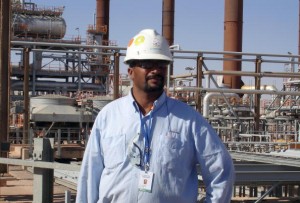How Fracking Could Disrupt CO2 Sequestration
-
Susan Phillips

STR/AFP/Getty Images
A technician stands in front of the Krechba carbon capture and sequestration treatment plant in Algeria.
The goal of carbon dioxide sequestration is to bury the harmful greenhouse gas thousands of feet underground. The goal of fracking is to release natural gas from deeply buried deposits. So, can the two coexist within close range? A recent study published in February by two Princeton University engineering professors tries to answer that question with their paper “Potential Restrictions for CO2 Sequestration Sites Due to Shale and Tight Gas Production.”
“Production of natural gas from shale and other tight formations involves fracturing the shale with the explicit objective to greatly increase the permeability of the shale. As such, shale gas production is in direct conflict with the use of shale formations as a caprock barrier to CO2 migration.”
Shale is considered a good lid to keep the CO2 from leaking back out into the atmosphere. But hydraulic fracturing, using high pressured water to fracture the rock, and sand to keep those fractures open, could end up poking holes in that lid. It all depends on how much CO2 sequestration happens near frack jobs. And that’s what the researchers, T.R. Eliot and M.A. Celia, looked at.
“These analyses indicate that colocation of deep saline aquifers with shale and tight gas production could significantly affect the sequestration capacity for CCS operations. This suggests that a more comprehensive management strategy for subsurface resource utilization should be developed.”
But Briana Mordick, from the Natural Resources Defense Council explains in her blog on the new report that the two could safely co-exist if more sub-surface formations lie on top of the shale and serve as a protective cover.
“For example, the portion of the Marcellus Shale that is targeted by gas drillers is only 50-100 feet thick and above it are thousands more feet of shale and other low permeability rocks. In other words, even if a small section of a caprock is fractured, the larger formation could still serve as a seal, and will often have multiple seals above it in addition.”
What Brianna is really worried about, however, and what is not addressed in the paper, is how poor well construction might serve as a conduit for the CO2 to escape.
“If the formations that these oil and gas wells are drilled into eventually become the caprock for CO2 sequestration projects, these wells could be exposed to harsh conditions they haven’t been designed to withstand, potentially creating thousands of new pathways for CO2 to escape to the atmosphere.”
Faulty wells have been blamed for methane migration in towns like Dimock, Pennsylvania.
















